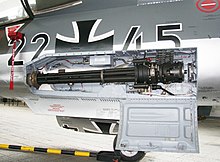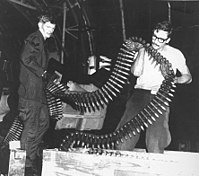M61 Vulcan
| M61 Vulcan | |
|---|---|
| General Information | |
| Military designation: | M61 |
| Manufacturer country: | United States |
| Developer / Manufacturer: | General Electric |
| Development year: | 1946 |
| Start of production: | 1959 |
| Model variants: | M61, M61A1, M61A2 |
| Weapon Category: | Gatling cannon |
| Technical specifications | |
| Caliber : |
20 × 102 mm |
| Number of trains : | 9 |
| Twist : | right progressive |
| Cadence : | 4000 or 6000 (-6600) rounds / min |
| Furnishing | |
| Ammunition supply: | strapless or belted |
| Drive: | hydraulic |
| Muzzle velocity: | 1030-1050 m / s |
The M61 GAU-4 20 mm Vulcan is a hydraulically driven sechsläufige Gatling - machine gun with electric firing from American production.
history
Since after the Second World War, with the introduction of jet engines, the aircraft and thus the air combat became faster and faster, the pilots had even less time than before to shoot before the target possibly moved out of the range of the on-board cannons. Single-barrel guns were largely exhausted in terms of rate of fire and durability. The Gatling system in Anno 1861, which was regarded as antiquated at the time, made it possible, however, to fire a large number of projectiles at the target in a short time thanks to its multi-barrel rotating construction.
The US Army therefore experimented from 1946 as part of the Vulcan project with Gatling guns of various calibers . The most promising of these was the 20mm model, for which General Electric received its first large-scale order in 1956. The new aircraft gun was standardized as the M61 Vulcan. The disadvantages of the Gatling concept - heavy construction and high propulsion power of the weapon - did not pose a problem, as modern combat aircraft had the appropriate load capacity and the necessary powerful on-board systems.
use

The automatic cannon is used as an on-board weapon in most American combat aircraft , especially at short distances, where heat-controlled air-to-air missiles can no longer be used. Although it is primarily an air-to-air gun, it can also be used against ground targets or as an anti-aircraft gun (FlaK).
The cadence can be set to 4000 or 6000 rounds per minute. At the full rate of fire of 6000 rounds per minute, around 25 kW are required to propel the cannon.
Working principle
The six barrels of the M61 are arranged around a rotating shaft. Each pipe is loaded and fires when it reaches the top position. In addition to the high rate of fire (cadence) of around 100 rounds per second, there is less wear and tear and less heating of the barrels. The weapon has an enormous shot density , but it is only reached with a delay of 0.3 seconds. Depending on the model, the Vulcan cannons can be loaded with 940 (AD model) or 500 cartridges (E model) of various types of ammunition, for example target practice, armor-piercing or high-explosive ammunition.
Platforms
- Lockheed F-104 "Starfighter"
- Republic F-105 "Thunderchief"
- Convair F-106 "Delta Dart" (installed in the missile weapon bay)
- General Dynamics F-111 "Aardvark" (installed in the weapon bay)
- McDonnell Douglas F-4 "Phantom II" (from variant F-4E)
- Vought A-7 "Corsair II" (from variant A-7B)
- Convair B-58 "Hustler" (rear gun)
- Boeing B-52H "Stratofortress" (rear gun)
- McDonnell Douglas F-15 "Eagle"
- Lockheed F-16 "Fighting Falcon"
- Grumman F-14 "Tomcat"
- McDonnell Douglas F / A-18 "Hornet" & "Superhornet"
- Lockheed F / A-22 "Raptor"
- Alenia / Embraer "AMX"
- KAI T-50 "Golden Eagle"
- Lockheed AC-130 "Specter"
- Mitsubishi F-1
- SUU-16 / A , external weapon container for combat aircraft
- M163 Vulcan , flak tank
- Phalanx CIWS , short-range defense system on warships
variants
- M61 : basic version with cartridge belt (no longer in production)
- M61A1 : Improved strapless version (weight 112.5 kg)
- M61A2 : Light version (91.6 kg) with thinner runs that in the 1990s for the 18 A-Hornet F / developed
- M35 : Three-barrel variant with shorter barrels and reduced cadence
A derived development are the minigun machine guns, which, with their smaller rifle caliber, are used to combat unarmored ground targets, especially in the context of gunship operations. A further development as GAU-7 failed in 1974.
Web links
- M61 in the weapons database the Federation of American Scientists (English)
- M61 A1 Vulcan in F-16.net (English)



